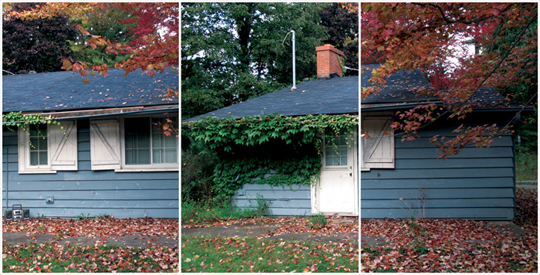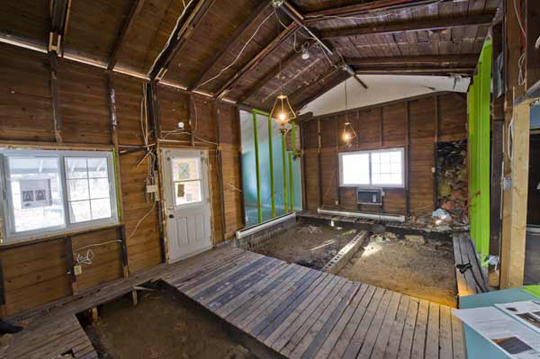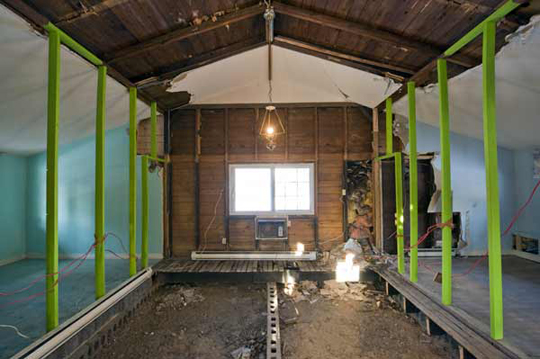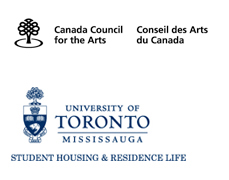
January 27 - March 7, 2010
Curated by Christof Migone





Wed Jan 27, 6-9 pm. Opening Reception. Artists in attendance. A free bus leaves OCAD (100 McCaul Street, Toronto) at 6:30 pm and returns to OCAD at 9 pm.
Artists in attendance. A free bus leaves OCAD (100 McCaul Street, Toronto) at 6:30 pm and returns to OCAD at 9 pm.
Wed Jan 20, 2pm. Hard Hat Tour. Starting at the Blackwood Gallery, touring the e|gallery, and the old Cottage site, with a final stop at the Blind Duck Pub.
Sun Jan 31, 11:30-5 pm. FREE Contemporary Art Bus Tour. Tour starts at 11:30 am at 23 Beverly Street (Koffler Centre off-site space) and then departs for Blackwood, Art Gallery of York University and Doris McCarthy Gallery. To make a reservation, contact the Blackwood Gallery at blackwood.gallery@utoronto.ca or 905-828-3789.
Mon March 1, 2-4 pm. The Blackwood Talks: Location is Everything: site and non-site in the work of Christine Swintak and Don Miller. A talk by Michelle Jacques (Independent Curator and Associate Curator, Contemporary Art, Art Gallery of Ontario). In the Blackwood Gallery.
Wednesdays @ 1pm. THE BLACKWOOD BREAKS. Join us for a FREE coffee and a short guided tour of the exhibition. Each tour is hosted by a different UTM staff or faculty member who will offer a unique perspective on the project. All tours start at 1pm at the Blackwood Gallery (Kaneff), and continue to the e|gallery (CCT) and Thomas Cottage.
Schedule
February 3rd - Juliana Zalucky, M.A., Exhibition Coordinator, Blackwood Gallery
February 10th - Amish Morrell, PhD., Faculty and Editor of C Magazine
February 24th - Jessica Eylon, M.A., Assistant to the Director, ICC
March 3rd – Marc Dryer, MSc and MScBMC, Senior Lecturer, Biomedical Communications
Three sites. Three stages. Three locations, and one event intertwines the three. First, in one location, a cottage is demolished. Second, the cottage is reconstituted in our two gallery locations as a temporary display which functions simultaneously as an architectural autopsy, a time capsule, a resuscitation, a dump display, a scavenger manual, a surgical dismantlement, a reverse gentrification, a study of inefficiency, an erased erasure, and a memento mori. The second stage enacts a delayed forgetting, it forestalls the inevitable discarding, it impedes the third unknowable stage of oblivion from ever occurring. Christine Swintak and Don Miller intervene in the course of a campus in the midst of a growth spurt; they balance the equation whereby as new buildings break ground and emerge, others fade underground. The cottage in question, the Thomas Cottage, is a small late 19th century building that sits in the middle of the UTM campus and precedes the establishment of the campus and even its predecessor, Erindale College. The artists methodically take apart the dilapidated and maligned cottage and not only stage a slowing down of its destruction, they also animate and transform it into a chimerical entity. The cottage, now in a post-mortem state and no longer listed in the property registry, enters the realm of sitelessness. Robert Smithson described his non-sites as "maps of material" which not only delimit space but also "involve a consciousness of time."(1) Swintak and Miller provide a similar sensitivity to this continuum. The layered histories of the cottage, from the banal to the apocryphal, are present in both gallery spaces. Their tripartite rant (good cop, bad cop, no cop) anthropomorphize the cottage in order to address it as the subject of their ire, their desire, and their baffled silence in the face of this anachronistic presence. The installation presents a portal to a pastoral past, but also reflects its university-based gallery setting as a white cubed cog in the knowledge industry. Neither narrative is idealized or demonized, in other words, the project acknowledges the fissures and fractures inherent in architecture. The invisible structures of society are made manifest in the structures of our buildings. In Georges Bataille's pithy and peculiar definition of architecture, he argues that the human form is but an intermediary stage of evolution towards the more advanced and authoritative form of buildings (he focuses on monuments in particular).(2) In short, architecture not only speaks volume, it also speaks power. Consequently, with a conviction that is both resolute and risible, Swintak and Miller pervert the conventions and dub the cottage a sovereign. In honor of what would otherwise be an unnoticed demise, they then produce an installation which proclaims, The Cottage is dead! Long live the Cottage!
Christof Migone, Director/Curator
Christine Swintak is a Toronto-based visual artist who works in a number of media including performance, intervention, installation and multimedia. She has exhibited at galleries, festivals and museums across Canada and internationally, including HMK Mariakapel (Holland), Model Niland (Ireland), DCR Guest Studios (Holland), YYZ Artist's Outlet (Toronto), Toronto Free Gallery (Toronto), Nuit Blanche (Toronto), Art Gallery of Ontario (Toronto), ArtCity Festival of Art and Architecture (Calgary), Khyber Centre for the Arts (Halifax), Dalhousie University Art Gallery (Halifax) and Rockefeller Centre (New York). Swintak has also presented numerous independent public interventions and relational happenings in places like Shelburne, Amsterdam, Banff, Vancouver, Teslin, New York, Salt Lake City, Death Valley and Los Angeles. Her projects include building a full scale ship through collective improvisation, running an election party campaign for the Irish underworld, transforming a dumpster into a luxury boutique hotel, promoting urban quicksand pits, creating a symmetrical frontispiece out of two mirrored rooms, attempting to give a shed a consciousness, and producing a series of impossible project proposals. Swintak received a BFA in 2003 from NSCAD University and is committed to continual self-directed research.
Don Miller is an idea-based visual artist, intuitive carpenter and poet who lives near Shelburne, Ontario. Miller works in a number of media including performance, video, installation, experimental architecture, snow sculpture and written word. He also works with stone, steel and wood to generate income to fund his artistic pursuits; his creative endeavours tend to infiltrate his life, and his life tends to infiltrate his art. Though the majority of his projects are produced independently, outside the gallery network, Miller has also presented performances, videos, readings and interventions at Ghost Ship (Amsterdam), York University (Toronto), Knock on Woods (Holland), Pleasure Dome/ Cinecycle (Toronto), Engine Gallery (Toronto), Tranzac (Toronto), and Anna Leonowens Gallery (Halifax). His projects include an ongoing series of sensory deprivation and/or sensory enhancement snow caves, a large one of a kind frankenhouse constructed from numerous century old barns, spoken word performances at various venues, and creating what he terms "a strategy for living." Don received a BFA in 2002 from NSCAD University (formerly the Nova Scotia College of Art and Design).
Christine Swintak and Don Miller met at NSCAD in 1998. Though they have been involved with each other's projects for the past decade, this is their first large scale exhibition working together as an equal authorship collaborative. Neither Swintak nor Don had a cottage in their childhood.
Generous supported by the Canada Council for the Arts and the University of Toronto Student Housing & Residence Life.
Design by Christine Swintak.
